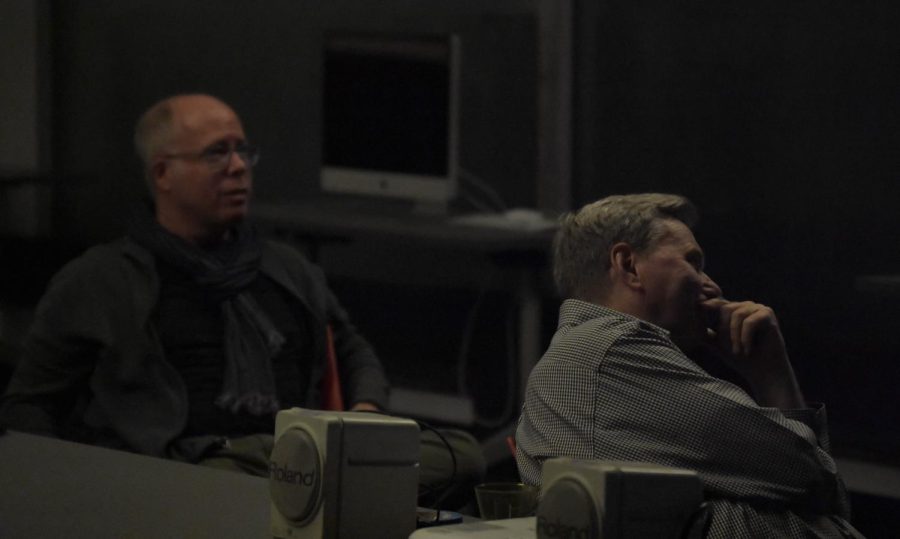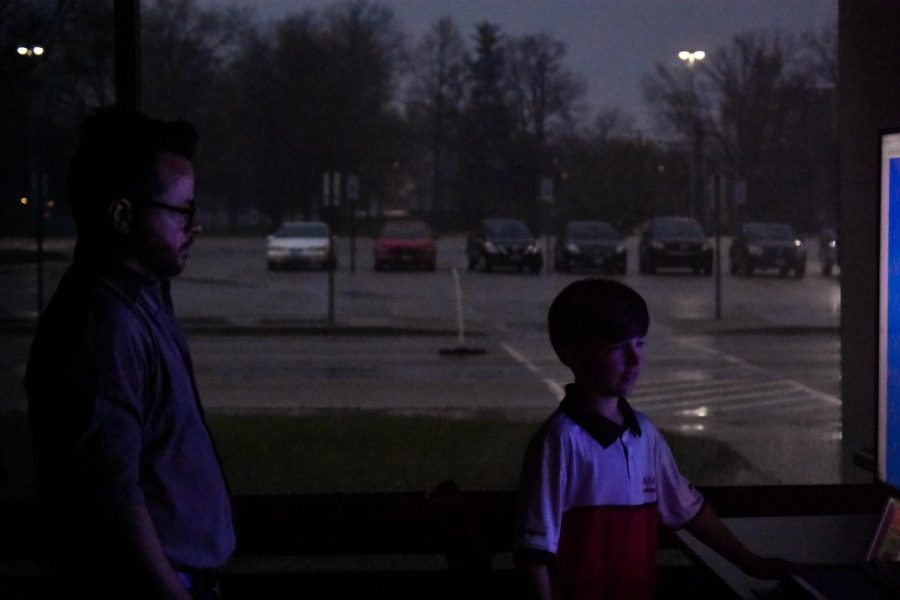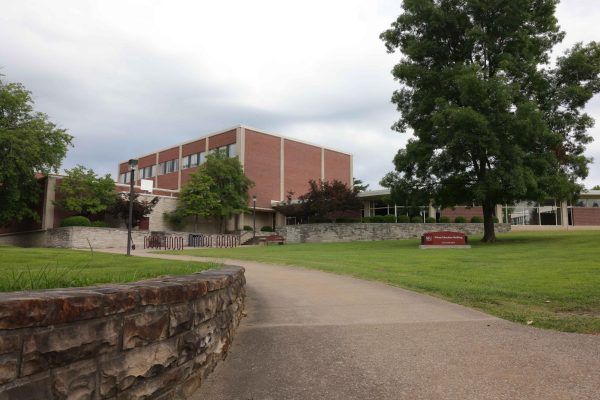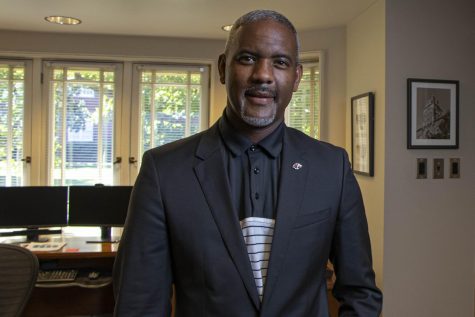School of Media Arts presents faculty showcase
Trevor Reaman | [email protected]
Professors Jay Needham and H.D. Motyl presented pieces during CAMFest on April 11, 2022 at the SIU Communications Building in Carbondale, Ill. After the exhibition of their pieces, they joined in on a Q&A later in the night, talking about their inspirations for their pieces and the creative process during the pandemic.
When four buttons were simultaneously pressed, the corresponding computer screens lit up with videos of H.D. Motyl, the associate dean of CAM, shaving his head.
The Southern Illinois University (SIU) School of Media Arts presented a faculty showcase Monday, April 11 from 7-9 p.m. as part of the College of Arts and Media (CAM) Festival. The projects presented at the showcase ranged from those meant for the big screen to still images and videos.
Motyl said he was inspired by the pandemic to make this video because his hair had become too long and he needed to cut it.
Advertisement
“There’s a photographer named Barbara Probst who does these still photographs and covers moments with two to ten cameras and I’ve always wanted to do something like that,” Motyl said.
Motyl said he had other scenarios in mind, but chose this project because he needed to cut his hair, he had all the equipment, and no students were using it.
“I got the equipment room manager, Connor Felson, to help me and so I was able to cut my hair while doing an experiment in video-making,” Motyl said.
Artist Aidan Levoi had an art project where she set up various figurines in looping circles to represent birth, death and chaos.
Levoi said she based the written description of the art piece on her own unique language.
“It’s based on the rules of Middle English, as well as some rules of Latin, German, and Spanish. I really like how in Spanish, there’ll be a question mark upside down at the beginning, for an exclamation point upside down at the beginning, because then you don’t have to get to the end of the sentence to know if it’s a question or an exclamation if you’re reading it out loud,” Levoi said.
Interim director for the school of media arts Robert Spahr had a three piece video sequence.
Advertisement*
The first video was called Misdirection Cruft. A computer software grabs images from corporate software and Youtube, Spahr said. The software combined images from car crashes uploaded onto the platform and the corporate imagery along with the theme song and quotes from the sitcom “All In the Family.”
Spahr said he produces a new video every day and all three of his videos being presented were automated.
“The next piece is footage from 9/11 and text from Tucker Carlson’s show, so it’s kind of connecting 9/11 to our present as the text is what’s going on today,” Spahr said.
Spahr said there’s no footage of the Twin Towers themselves, only people reacting to the situation. The third video consists of images of school photos of children with text from CNN headlines.
“I made that third video the day of the January 6 attack on the Capitol, and the next three videos are on my website: robertspahr.com,” Spahr said.
Gallery viewer and cinema instructor Cinzia Padovani said she couldn’t choose a favorite but enjoyed Motyl, Spahr and Kalayeh’s videos.
Walter Metz, a cinema instructor, did a presentation on the fusion of pedagogy and art targeted at students learning to be artists.
Metz said it surprised him to see studies showing some students didn’t know how to find Mexico on a map or how to form a historical timeline.
“One of my experiences teaching civil rights is that some students put the Civil War in the 20th century and World War 1 in the 19th century,” Metz said.
Metz said he wants to present students with ways of thinking about the world through mapping.
He presented two maps of the world and explained about different geographical areas like the Middle East and Africa.
Metz said he presented a film about the world made by a Ukrainian director in his Islamic cinema class the morning Russia invaded Ukraine.
“I said to my Islamic cinema class that I didn’t know any Chechen cinema but at the very least this is a way of thinking about how Putin’s assault on civilization is manifested in a way as art serves as a tool to strike back against the government,” Metz said.
Metz said another useful outcome of mapping in geography is the teaching of international cinema, which, in its most basic framework, assumes the nation-state is the primary unit for analysis, which is both unproductive and untrue.
Metz said he wrote an essay on a Malian film called “Genesis,” a reinterpretation of the Abrahamic story of Jacob and Esau and how the film is funded with French money.
“So on the first day of class, I’m going to give the students a blank piece of paper and ask them to draw me the world and on the last day of class, I’m going to ask them to do the same thing,” Metz said.
Metz said he hopes this allows students to engage in different media cultures from around the world.
Radio, television and design instructor Jay Needham spoke on a series of sketches he created
Needham said it’s the first time he’s sharing the sketches and he started making them when COVID-19 started and his mother was dying. He would go down to the studio, sketch scenes and work on improvising them.
“And it was really kind of a fun journey in some regard and they weren’t completely done but they began to feel like scenes, only without characters,” Needham said.
Needham said he enjoys using the piano as an instrument to accompany his sketches and he enjoys the power of music.
Kalayeh said that there were multiple ways of doing virtual journaling including making TikToks and collaborating with others over the span of thirty days where people contribute without seeing what others are creating.
Kalayeh talked about some projects he made including one called Creating Across the Media where his students created spontaneous films and distributed them over the internet and social media platforms.
“One of the lessons was poetic cinema so I started looking at Yoko Ono’s poems and found one where she talks about not saying anything negative about others for three days, thirty days, and then for ninety days,” Kalayeh said.
Kalayeh said he started making TikToks and Youtube videos based on that concept and as people responded to them, they became characters in the film.
“This idea of bringing TikTok to the University Museum is very refreshing,” Kalayeh said.
Staff reporter Joel Kottman can be reached at [email protected] and on Twitter: @JoelKottman. To stay up to date with all your Southern Illinois news, follow the Daily Egyptian on Facebook and Twitter.
Advertisement











